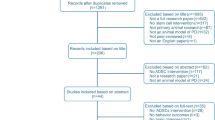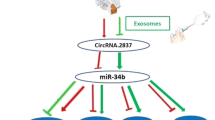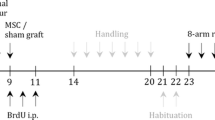Abstract
Parkinson’s disease (PD) is a chronic neurodegenerative disease. Unfortunately, the effectiveness of anti-Parkinson treatments gradually diminishes owing to the progressive degeneration of the dopaminergic terminals. The research described here investigated the effect of adipose-derived mesenchymal stem cells (AD-MSC) versus that of an anti-Parkinson drug in a rat model of Parkinsonism. Forty adult rats were divided into four equal groups, each group receiving a different treatment: vehicle, rotenone, rotenone + AD-MSC, or rotenone + carbidopa/levodopa. Behavioral tests were carried out before and at the end of the treatment and specimens harvested from the midbrain were processed for light and electron microscopy. Genetic expression of glial fibrillary acidic protein (GFAP) and Nestin mRNA was assessed. Expression of the Lamin-B1 and Vimentin genes was measured, along with plasma levels of Angiopoietin-2 and dopamine. Treatment with rotenone induced pronounced motor deficits, as well as neuronal and glial alterations. The AD-MSC group showed improvements in motor function in the live animals and in the microscopic picture presented by their tissues. The fold change of both genes (GFAP and Nestin) decreased significantly in the AD-MSC and carbidopa/levodopa groups compared to the group with Parkinson’s disease. Plasma levels of Angiopoietin-2 and dopamine were significantly increased after treatment (P < 0.001) compared to levels in the rats with Parkinson’s disease. AD-MSC reduced neuronal degeneration more efficiently than did the anti-Parkinson drug in a rat model of Parkinsonism.










Similar content being viewed by others
Data availability
Available upon request.
Change history
29 December 2023
This article has been retracted. Please see the Retraction Notice for more detail: https://doi.org/10.1007/s11033-023-09143-4
Abbreviations
- AD-MSC:
-
Adipose-derived mesenchymal stem cells
- PD:
-
Parkinson’s disease
- CP:
-
Cerebral peduncle
- SN:
-
Substantia nigra
- SNc:
-
Substantia nigra pars compacta
- SNr:
-
Substantia nigra pars reticulate
- TH:
-
Tyrosine hydroxylase
- GFAP:
-
Glial fibrillary acidic protein
- Vim:
-
Vimentin
- Nes:
-
Nestin
- FACS:
-
Fluorescence-activated cell sorting
- BBB:
-
Blood–brain barrier
References
Tanner CM, Goldman SM (1996) Epidemiology of Parkinson’s disease. Neurol Clin 14:317–335
Zhang ZN, Zhang JS, **ang J, Yu ZH, Zhang W, Cai M, Li XT, Wu T, Li WW, Cai DF (2017) Subcutaneous rotenone rat model of Parkinson’s disease: dose exploration study. Brain Res 1655:104–113
Olanow CW, Tatton WG (1999) Etiology and pathogenesis of Parkinson’s disease. Annu Rev Neurosci 22:123–144
Carta AR, Mulas G, Bortolanza M, Duarte T, Pillai E, Fisone G, Vozari RR, Del-Bel E (2017) l-DOPA-induced dyskinesia and neuroinflammation: do microglia and astrocytes play a role? Eur J Neurosci 45:73–91
Pekny M, Wilhelmsson U, Bogestal YR, Pekna M (2007) The role of astrocytes and complement system in neural plasticity. Int Rev Neurobiol 82:95–111
Ekmark-Lewen S, Lewen A, Israelsson C, Li GL, Farooque M, Olsson Y, Ebendal T, Hillered L (2010) Vimentin and GFAP responses in astrocytes after contusion trauma to the murine brain. Restor Neurol Neurosci 28:311–321
Hallmann R, Horn N, Selg M, Wendler O, Pausch F, Sorokin LM (2005) Expression and function of laminins in the embryonic and mature vasculature. Physiol Rev 85:979–1000
Fujiwara H, Gu J, Sekiguchi K (2004) Rac regulates integrin-mediated endothelial cell adhesion and migration on laminin-8. Exp Cell Res 292:67–77
Carbone M, Duty S, Rattray M (2012) Riluzole neuroprotection in a Parkinson’s disease model involves suppression of reactive astrocytosis but not GLT-1 regulation. BMC Neurosci 13:38
Nakagawa T, Schwartz JP (2004) Gene expression profiles of reactive astrocytes in dopamine-depleted striatum. Brain Pathol 14:275–280
Jucker M, Tian M, Norton DD, Sherman C, Kusiak JW (1996) Laminin alpha 2 is a component of brain capillary basement membrane: reduced expression in dystrophic dy mice. Neuroscience 71:1153–1161
Zhang P, Li J, Liu Y, Chen X, Lu H, Kang Q, Li W, Gao M (2011) Human embryonic neural stem cell transplantation increases subventricular zone cell proliferation and promotes peri-infarct angiogenesis after focal cerebral ischemia. Neuropathology 31:384–391
Mine Y, Tatarishvili J, Oki K, Monni E, Kokaia Z, Lindvall O (2013) Grafted human neural stem cells enhance several steps of endogenous neurogenesis and improve behavioral recovery after middle cerebral artery occlusion in rats. Neurobiol Dis 52:191–203
Choi HS, Kim HJ, Oh JH, Park HG, Ra JC, Chang KA, Suh YH (2015) Therapeutic potentials of human adipose-derived stem cells on the mouse model of Parkinson’s disease. Neurobiol Aging 36:2885–2892
Sharma N, Nehru B (2013) Beneficial effect of vitamin E in rotenone induced model of PD: behavioural, neurochemical and biochemical study. Exp Neurobiol 22:214–223
Javed H, Azimullah S, Abul Khair SB, Ojha S, Haque ME (2016) Neuroprotective effect of nerolidol against neuroinflammation and oxidative stress induced by rotenone. BMC Neurosci 17:58
Abo-Grisha N, Essawy S, Abo-Elmatty DM, Abdel-Hady Z (2013) Effects of intravenous human umbilical cord blood CD34 + stem cell therapy versus levodopa in experimentally induced Parkinsonism in mice. Arch Med Sci 9:1138–1151
Lu J, Kanji S, Aggarwal R, Das M, Joseph M, Wu LC, Mao HQ, Pompili VJ, Hadjiconstantinou M, Das H (2013) Hematopoietic stem cells improve dopaminergic neuron in the MPTP-mice. Front Biosci 18:970–981
Fischer UM, Harting MT, Jimenez F, Monzon-Posadas WO, Xue H, Savitz SI, Laine GA, Cox CS Jr (2009) Pulmonary passage is a major obstacle for intravenous stem cell delivery: the pulmonary first-pass effect. Stem Cells Dev 18:683–692
Chompoopong S, Jarungjitaree S, Punbanlaem T, Rungruang T, Chongthammakun S, Kettawan A, Taechowisan T (2016) Neuroprotective effects of germinated brown rice in rotenone-induced Parkinson’s-like disease rats. NeuroMol Med 18:334–346
Recchia A, Rota D, Debetto P, Peroni D, Guidolin D, Negro A, Skaper SD, Giusti P (2008) Generation of a alpha-synuclein-based rat model of Parkinson’s disease. Neurobiol Dis 30:8–18
von Wrangel C, Schwabe K, John N, Krauss JK, Alam M (2015) The rotenone-induced rat model of Parkinson’s disease: behavioral and electrophysiological findings. Behav Brain Res 279:52–61
Sedelis M, Schwarting RK, Huston JP (2001) Behavioral phenoty** of the MPTP mouse model of Parkinson’s disease. Behav Brain Res 125:109–125
Singh N, Bansal Y, Bhandari R, Marwaha L, Singh R, Chopra K, Kuhad A (2017) Resveratrol protects against ICV collagenase-induced neurobehavioral and biochemical deficits. J Inflamm 14:14
Woode E, Amidu N, Owiredu WKBA, Boakye-Gyasi E, Laing EF, Ansah C, Duwiejua M (2009) Anxiogenic-like effects of a root extract of sphenocentrum jollyanum pierre in murine behavioural models. J Pharmacoland Toxicol 4:91–106
Lee HC, An SG, Lee HW, Park JS, Cha KS, Hong TJ, Park JH, Lee SY, Kim SP, Kim YD, Chung SW, Bae YC, Shin YB, Kim JI, Jung JS (2012) Safety and effect of adipose tissue-derived stem cell implantation in patients with critical limb ischemia: a pilot study. Circ J 76:1750–1760
Yamamoto N, Akamatsu H, Hasegawa S, Yamada T, Nakata S, Ohkuma M, Miyachi E, Marunouchi T, Matsunaga K (2007) Isolation of multipotent stem cells from mouse adipose tissue. J Dermatol Sci 48:43–52
Kozina EA, Khaindrava VG, Kudrin VS, Kucherianu VG, Klodt PD, Bocharov EV, Raevskii KS, Kryzhanovskii GN, Ugriumov MV (2010) Experimental modeling of functional deficiency of the nigrostriatal dopaminergic system in mice. Ross Fiziol Zh Im I M Sechenova 96:270–282
Wang T, Liu YY, Wang X, Yang N, Zhu HB, Zuo PP (2010) Protective effects of octacosanol on 6-hydroxydopamine-induced Parkinsonism in rats via regulation of ProNGF and NGF signaling. Acta Pharmacol Sin 31:765–774
Gupta PD (1983) Ultrastructural study on semithin section. Sci Tools 30:6–7
Livak KJ, Schmittgen TD (2001) Analysis of relative gene expression data using real-time quantitative PCR and the 2(-Delta Delta C(T)) Method. Methods 25:402–408
Fernandez M, Negro S, Slowing K, Fernandez-Carballido A, Barcia E (2011) An effective novel delivery strategy of rasagiline for Parkinson’s disease. Int J Pharm 419:271–280
Matsuura K, Kabuto H, Makino H, Ogawa N (1997) Pole test is a useful method for evaluating the mouse movement disorder caused by striatal dopamine depletion. J Neurosci Methods 73:45–48
Zaitone SA, Abo-Elmatty DM, Elshazly SM (2012) Piracetam and vinpocetine ameliorate rotenone-induced Parkinsonism in rats. Indian J Pharmacol 44:774–779
Ooigawa H, Nawashiro H, Fukui S, Otani N, Osumi A, Toyooka T, Shima K (2006) The fate of Nissl-stained dark neurons following traumatic brain injury in rats: difference between neocortex and hippocampus regarding survival rate. Acta Neuropathol 112:471–481
Fa YH, Ni JQ, Wu XJ, Tan JQ, Wu YW (2016) Evaluation of the early response and mechanism of treatment of Parkinson’s disease with L-dopa using (18)F-fallypride micro-positron emission tomography scanning. Exp Ther Med 11:101–109
Zhang QS, Heng Y, Mou Z, Huang JY, Yuan YH, Chen NH (2017) Reassessment of subacute MPTP-treated mice as animal model of Parkinson’s disease. Acta Pharmacol Sin 38:1317–1328
Anglade P, Vyas S, Javoy-Agid F, Herrero MT, Michel PP, Marquez J, Mouatt-Prigent A, Ruberg M, Hirsch EC, Agid Y (1997) Apoptosis and autophagy in nigral neurons of patients with Parkinson’s disease. Histol Histopathol 12:25–31
Rendon WO, Martinez-Alonso E, Tomas M, Martinez-Martinez N, Martinez-Menarguez JA (2013) Golgi fragmentation is Rab and SNARE dependent in cellular models of Parkinson’s disease. Histochem Cell Biol 139:671–684
Cannon JR, Tapias V, Na HM, Honick AS, Drolet RE, Greenamyre JT (2009) A highly reproducible rotenone model of Parkinson’s disease. Neurobiol Dis 34:279–290
Exner N, Treske B, Paquet D, Holmstrom K, Schiesling C, Gispert S, Carballo-Carbajal I, Berg D, Hoepken HH, Gasser T, Kruger R, Winklhofer KF, Vogel F, Reichert AS, Auburger G, Kahle PJ, Schmid B, Haass C (2007) Loss-of-function of human PINK1 results in mitochondrial pathology and can be rescued by parkin. J Neurosci 27:12413–12418
Poole AC, Thomas RE, Andrews LA, McBride HM, Whitworth AJ, Pallanck LJ (2008) The PINK1/Parkin pathway regulates mitochondrial morphology. Proc Natl Acad Sci USA 105:1638–1643
Niranjan R, Nath C, Shukla R (2010) The mechanism of action of MPTP-induced neuroinflammation and its modulation by melatonin in rat astrocytoma cells, C6. Free Radic Res 44:1304–1316
Cali C, Baghabra J, Boges DJ, Holst GR, Kreshuk A, Hamprecht FA, Srinivasan M, Lehvaslaiho H, Magistretti PJ (2016) Three-dimensional immersive virtual reality for studying cellular compartments in 3D models from EM preparations of neural tissues. J Comp Neurol 524:23–38
Devos D, Lebouvier T, Lardeux B, Biraud M, Rouaud T, Pouclet H, Coron E, Bruley des Varannes S, Naveilhan P, Nguyen JM, Neunlist M, Derkinderen P (2013) Colonic inflammation in Parkinson’s disease. Neurobiol Dis 50:42–48
Gao HM, Liu B, Zhang W, Hong JS (2003) Critical role of microglial NADPH oxidase-derived free radicals in the in vitro MPTP model of Parkinson’s disease. FASEB J 17:1954–1956
Chen X, Lan X, Roche I, Liu R, Geiger JD (2008) Caffeine protects against MPTP-induced blood-brain barrier dysfunction in mouse striatum. J Neurochem 107:1147–1157
Lee H, Pienaar IS (2014) Disruption of the blood-brain barrier in Parkinson’s disease: curse or route to a cure? Front Biosci 19:272–280
ElAli A, Theriault P, Rivest S (2014) The role of pericytes in neurovascular unit remodeling in brain disorders. Int J Mol Sci 15:6453–6474
Dore-Duffy P, Cleary K (2011) Morphology and properties of pericytes. Methods Mol Biol 686:49–68
Mayer CA, Brunkhorst R, Niessner M, Pfeilschifter W, Steinmetz H, Foerch C (2013) Blood levels of glial fibrillary acidic protein (GFAP) in patients with neurological diseases. PLoS ONE 8:e62101
Cabezas R, Avila M, Gonzalez J, El-Bacha RS, Baez E, Garcia-Segura LM, Jurado Coronel JC, Capani F, Cardona-Gomez GP, Barreto GE (2014) Astrocytic modulation of blood brain barrier: perspectives on Parkinson’s disease. Front Cell Neurosci 8:211
Bouchez G, Sensebe L, Vourc’h P, Garreau L, Bodard S, Rico A, Guilloteau D, Charbord P, Besnard JC, Chalon S (2008) Partial recovery of dopaminergic pathway after graft of adult mesenchymal stem cells in a rat model of Parkinson’s disease. Neurochem Int 52:1332–1342
van den Berge SA, Kevenaar JT, Sluijs JA, Hol EM (2012) Dementia in Parkinson’s Disease correlates with alpha-synuclein pathology but not with cortical astrogliosis. Parkinsons Dis 2012:420957
Hendrickson ML, Rao AJ, Demerdash ON, Kalil RE (2011) Expression of nestin by neural cells in the adult rat and human brain. PLoS ONE 6:e18535
Nagel S, Rohr F, Weber C, Kier J, Siemers F, Kruse C, Danner S, Brandenburger M, Matthiessen AE (2013) Multipotent nestin-positive stem cells reside in the stroma of human eccrine and apocrine sweat glands and can be propagated robustly in vitro. PLoS ONE 8:e78365
Freed CR, Greene PE, Breeze RE, Tsai WY, DuMouchel W, Kao R, Dillon S, Winfield H, Culver S, Trojanowski JQ, Eidelberg D, Fahn S (2001) Transplantation of embryonic dopamine neurons for severe Parkinson’s disease. N Engl J Med 344:710–719
Olanow CW, Goetz CG, Kordower JH, Stoessl AJ, Sossi V, Brin MF, Shannon KM, Nauert GM, Perl DP, Godbold J, Freeman TB (2003) A double-blind controlled trial of bilateral fetal nigral transplantation in Parkinson’s disease. Ann Neurol 54:403–414
Chang KA, Kim HJ, Joo Y, Ha S, Suh YH (2014) The therapeutic effects of human adipose-derived stem cells in Alzheimer’s disease mouse models. Neurodegener Dis 13:99–102
Rosova I, Dao M, Capoccia B, Link D, Nolta JA (2008) Hypoxic preconditioning results in increased motility and improved therapeutic potential of human mesenchymal stem cells. Stem Cells 26:2173–2182
Baum O, Gubeli J, Frese S, Torchetti E, Malik C, Odriozola A, Graber F, Hoppeler H, Tschanz SA (2015) Angiogenesis-related ultrastructural changes to capillaries in human skeletal muscle in response to endurance exercise. J Appl Physiol 119:1118–1126
Ryu S, Lee SH, Kim SU, Yoon BW (2016) Human neural stem cells promote proliferation of endogenous neural stem cells and enhance angiogenesis in ischemic rat brain. Neural Regen Res 11:298–304
Olsson AK, Dimberg A, Kreuger J, Claesson-Welsh L (2006) VEGF receptor signalling—in control of vascular function. Nat Rev Mol Cell Biol 7:359–371
Lopatina T, Bruno S, Tetta C, Kalinina N, Porta M, Camussi G (2014) Platelet-derived growth factor regulates the secretion of extracellular vesicles by adipose mesenchymal stem cells and enhances their angiogenic potential. Cell Commun Signal 12:26
Tan CY, Lai RC, Wong W, Dan YY, Lim SK, Ho HK (2014) Mesenchymal stem cell-derived exosomes promote hepatic regeneration in drug-induced liver injury models. Stem Cell Res Ther 5:76
Lee JK, Park SR, Jung BK, Jeon YK, Lee YS, Kim MK, Kim YG, Jang JY, Kim CW (2013) Exosomes derived from mesenchymal stem cells suppress angiogenesis by down-regulating VEGF expression in breast cancer cells. PLoS ONE 8:e84256
Ratushnyy A, Ezdakova M, Yakubets D, Buravkova L (2018) Angiogenic Activity of Human Adipose-Derived Mesenchymal Stem Cells Under Simulated Microgravity. Stem Cells Dev 27:831–837
Chen H, Fang J, Li F, Gao L, Feng T (2015) Risk factors and safe dosage of levodopa for wearing-off phenomenon in Chinese patients with Parkinson’s disease. Neurol Sci 36:1217–1223
Acknowledgments
The authors thank Professor Sanaa A. M.Elgayar for her support in electron microscopy processing and examination.
Funding
This research received no funding from any funding agencies.
Author information
Authors and Affiliations
Corresponding author
Ethics declarations
Conflict of interest
The authors have no conflicts of interest to disclose.
Ethical approval
The study protocol was approved by the Ethical Committee of the Faculty of Medicine, Assiut University. Assiut, Egypt. Approval reference number; 17300077.
Informed consent
The donors of the adipose tissue from which the MSCs were separated gave written informed consent prior to the study for their use and publication of the data.
Additional information
Publisher's Note
Springer Nature remains neutral with regard to jurisdictional claims in published maps and institutional affiliations.
This article has been retracted. Please see the retraction notice for more detail:https://doi.org/10.1007/s11033-023-09143-4
Rights and permissions
Springer Nature or its licensor (e.g. a society or other partner) holds exclusive rights to this article under a publishing agreement with the author(s) or other rightsholder(s); author self-archiving of the accepted manuscript version of this article is solely governed by the terms of such publishing agreement and applicable law.
About this article
Cite this article
Meligy, F.Y., Elgamal, D.A., Abd Allah, E.S.H. et al. RETRACTED ARTICLE: Testing alternatives: the use of adipose-derived mesenchymal stem cells to slow neurodegeneration in a rat model of Parkinson’s disease. Mol Biol Rep 46, 5841–5858 (2019). https://doi.org/10.1007/s11033-019-05018-9
Received:
Accepted:
Published:
Issue Date:
DOI: https://doi.org/10.1007/s11033-019-05018-9




